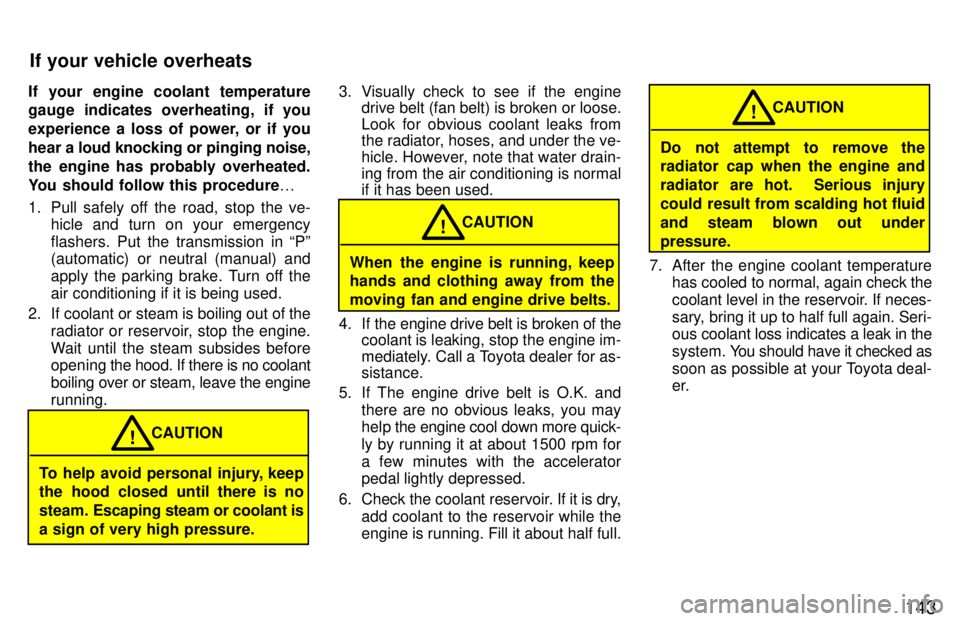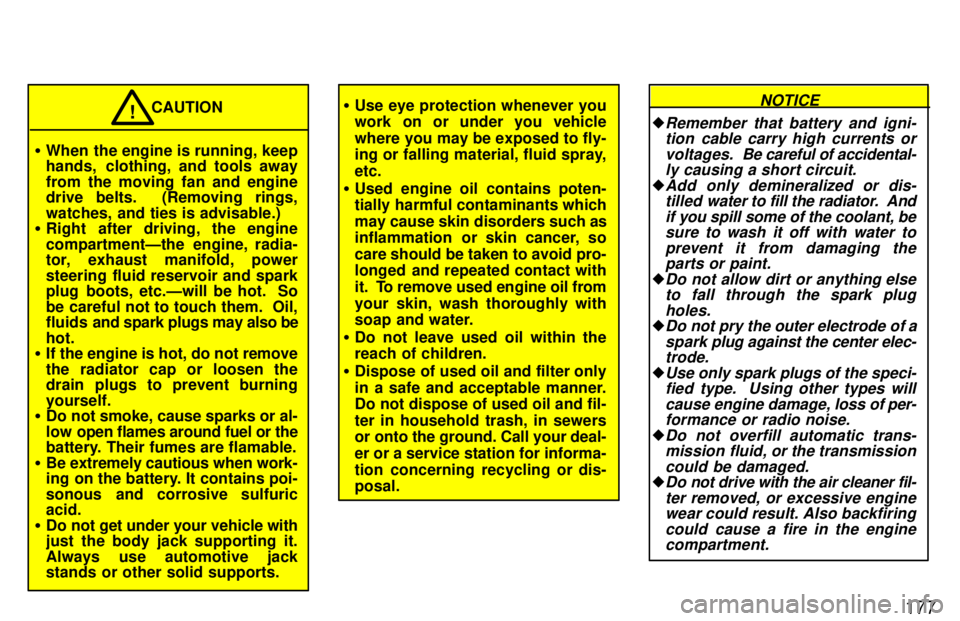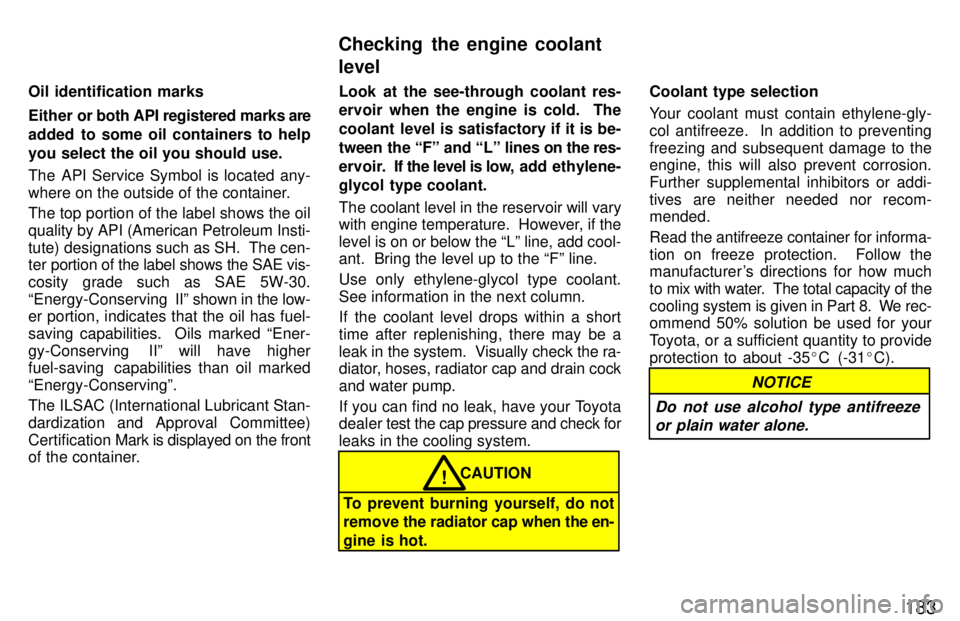1997 TOYOTA TACOMA radiator cap
[x] Cancel search: radiator capPage 132 of 221

131
Make sure you have ethylene-glycol
antifreeze in the radiator.
Do not use alcohol type antifreeze.
NOTICE
Check the condition of the battery and cables. Cold temperatures reduce the capacity of
any battery, so it must be in top shape to provide enough power for winter starting.Chapter 7-3 tells you how to visually in-
spect the battery. Your Toyota dealer and
most service stations will be pleased tocheck the level of charge.
Make sure the engine oil viscosity is
suitable for the cold weather.
See Chapter 7-2 for recommended vis-
cosity.
Leaving a heavy summer oil in your
vehicle during winter months may cause
harder starting. If you are not sure about
which oil to use, call your Toyota dealer- he will be pleased to help. Keep the door locks from freezing. Squirt lock de-icer or glycerine into the
locks to keep them from freezing. To open
a frozen lock, try heating the key before in-serting it. Use a washer fluid containing an anti-
freeze solution.
This product is available at your Toyota
dealer and most auto parts stores. Follow
the manufacturer's directions for how
much to mix with water.
Do not use engine antifreeze or any
other substitute because it may
damage your vehicle's paint.
NOTICE
Do not use your parking brake when there is a possibility it could freeze. When parking, put the transmission into
Pº (automatic) or into first or reverse
(manual) and block the front wheels. Do
not use the parking brake, or snow or wa-
ter accumulated in and around the parkingbrake mechanism may freeze, making it
hard to release. Keep ice and snow from accumulating
under the fenders.
Ice and snow built up under your fenders
can make steering difficult. During bad winter driving, stop and check under the
fenders occasionally. Depending on where you are driving,
we recommend you carry some emer- gency equipment.
Some of
the things you might put in the ve-
hicle are tire chains, window scraper, bag of sand or salt, flares, small shovel, jump- er cables, etc.
Winter driving tips
Page 144 of 221

143
If your engine coolant temperature
gauge indicates overheating, if you
experience a loss of power, or if you
hear a
loud knocking or pinging noise,
the engine has probably overheated.
You should follow this procedure 0
1. Pull safely off the road, stop the ve- hicle and turn on your emergency
flashers. Put the transmission in Pº
(automatic) or neutral (manual) and
apply the parking brake. Turn off the
air conditioning if it is being used.
2. If coolant or steam is boiling out of the radiator or reservoir, stop the engine.
Wait until the steam subsides before
opening the hood. If there is no coolant
boiling over or steam, leave the engine running.
To help avoid personal injury, keep
the hood closed until there is no steam. Escaping steam or coolant is
a sign of very high pressure. CAUTION
! 3. Visually check to see if the engine
drive belt (fan belt) is broken or loose.
Look for obvious coolant leaks from
the radiator, hoses, and under the ve-
hicle. However, note that water drain-ing from the air conditioning is normal if it has been used.
When the engine is running, keep
hands and clothing away from the
moving fan and engine drive belts. CAUTION
!
4. If the engine drive belt is broken of the coolant is leaking, stop the engine im-
mediately. Call a Toyota dealer for as- sistance.
5. If The engine drive belt is O.K. and there are no obvious leaks, you may
help the engine cool down more quick-
ly by running it at about 1500 rpm for
a few minutes with the accelerator
pedal lightly depressed.
6. Check the coolant reservoir. If it is dry, add coolant to the reservoir while the
engine is running. Fill it about half full.
Do not attempt to remove the
radiator cap when the engine and
radiator are hot. Serious injury
could result from scalding hot fluid
and steam blown out underpressure. CAUTION
!
7. After the engine coolant temperature has cooled to normal, again check the
coolant level in the reservoir. If neces-
sary, bring it up to half full again. Seri-
ous coolant loss indicates a leak in the
system. You should have it checked as
soon as possible at your Toyota deal-
er.
If your vehicle overheats
Page 178 of 221

177
�When the engine is running, keep
hands, clothing, and tools away
from the moving fan and engine
drive belts. (Removing rings,
watches, and ties is advisable.)
� Right after driving, the engine
compartmentÐthe engine, radia-
tor, exhaust manifold, power
steering fluid reservoir and spark
plug boots, etc.Ðwill be hot. So
be careful not to touch them. Oil,
fluids and spark plugs may also be
hot.
� If the engine is hot, do not remove
the radiator cap or loosen the
drain plugs to prevent burning yourself.
� Do not smoke, cause sparks or al-
low open flames around fuel or the
battery. Their fumes are flamable.
� Be extremely cautious when work-
ing on the battery. It contains poi-
sonous and corrosive sulfuric acid.
� Do not get under your vehicle with
just the body jack supporting it.
Always use automotive jack
stands or other solid supports. CAUTION
!�
Use eye protection whenever you
work on or under you vehicle
where you may be exposed to fly-
ing or falling material, fluid spray, etc.
� Used engine oil contains poten-
tially harmful contaminants which
may cause skin disorders such as
inflammation or skin cancer, so
care should be taken to avoid pro-
longed and repeated contact with
it. To remove used engine oil from
your skin, wash thoroughly with
soap and water.
� Do not leave used oil within thereach of children.
� Dispose of used oil and filter only
in a safe and acceptable manner.
Do not dispose of used oil and fil-
ter in household trash, in sewers
or onto the ground. Call your deal- er or a service station for informa-
tion concerning recycling or dis- posal. �
Remember that battery and igni-
tion cable carry high currents or
voltages. Be careful of accidental-
ly causing a short circuit.
�Add only demineralized or dis- tilled w ater to fill the radiator. And
if you spill some of the coolant, be sure to wash it off with water to
prevent it from damaging theparts or paint.
�Do not allow dirt or anything elseto fall through the spark plug
holes.
�Do not pry the outer electrode of aspark plug against the center elec-
trode.
�Use only spark plugs of the speci- fied type. Using other types will
cause engine damage, loss of per-
formance or radio noise.
�Do not overfill automatic trans- mission fluid, or the transmission
could be damaged.
�Do not drive with the air cleaner fil-ter removed, or excessive enginewear could result. Also backfiring
could cause a fire in the enginecompartment.
NOTICE
Page 184 of 221

183
Oil identification marks
Either or
both API registered marks are
added to some oil containers to help
you select the oil you should use.
The API Service Symbol is located any-
where on the outside of the container. The top portion of the label shows the oil
quality by API (American Petroleum Insti-
tute) designations such as SH. The cen-
ter portion of the label shows the SAE vis-
cosity grade such as SAE 5W-30.
Energy-Conserving IIº shown in the low-
er portion, indicates that the oil has fuel-
saving capabilities. Oils marked Ener-
gy-Conserving IIº will have higher
fuel-saving capabilities than oil marked Energy-Conservingº.
The ILSAC (International Lubricant Stan-
dardization and Approval Committee)Certification Mark is displayed on the front
of the container. Look at the see-through coolant res-
ervoir when the engine is cold. The
coolant level is satisfactory if it is be-
tween the Fº and Lº lines on
the res-
ervoir. If the level is low, add ethylene-
glycol type coolant.
The coolant level in the reservoir will vary
with engine temperature. However, if the level is on or below the Lº line, add cool- ant. Bring the level up to the Fº line. Use only ethylene-glycol type coolant. See information in the next column.
If the coolant level drops within a short
time after replenishing, there may be a
leak in the system. Visually check the ra-
diator, hoses, radiator cap and drain cock
and water pump.
If you can find no leak, have your Toyota
dealer test the cap pressure and check for
leaks in the cooling system.
To prevent burning yourself, do not
remove the radiator cap when the en-
gine is hot.
CAUTION! Coolant type selection
Your coolant must contain ethylene-gly- col antifreeze. In addition to preventingfreezing and subsequent damage to the
engine, this will also prevent corrosion. Further supplemental inhibitors or addi-
tives are neither needed nor recom- mended.
Read
the antifreeze container for informa-
tion on freeze protection. Follow the
manufacturer 's directions for how much
to mix with water. The total capacity of the
cooling system is given in Part 8. We rec-
ommend 50% solution be used for your
Toyota, or a sufficient quantity to provideprotection to about -35 �C (-31 �C).
Do not use alcohol type antifreeze
or plain water alone.
NOTICE
Checking the engine coolant level